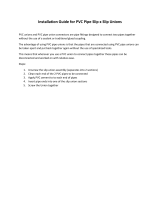
2.7 VALVES
Back Pressure Valves
All metering pumps are prone to overpumping (exces-
sive output) at low discharge pressures. To prevent this
condition from occurring, it is necessary to maintain
approximately 10 psi (0.7 bar) back pressure against
the pump. This can be accomplished through the in-
stallation of a back pressure valve in the discharge line.
Typically, the valve should be located near the pump.
However, back pressure valves for large pumps with long
and extremely small discharge lines may have to be
installed near the point of discharge into the process (to
minimize siphoning tendencies).
Pulsation Dampeners
An accumulator, surge chamber, surge suppressor, or
pulsation dampener should be used with the back pres-
sure valve in the discharge line to absorb the flow peaks
between the pump and the back pressure valve. With-
out the pulsation dampener the valve mechanism will
snap open and close with the surge from each pump
stroke. The pulsation dampener will allow the back pres-
sure valve to oscillate about a partly-closed position,
thus minimizing wear on the valve. Discharge line pul-
sation dampeners offer the further advantage of limiting
the flow and pressure variations characteristic of this
kind of pump. Installing a properly sized pulsation damp-
ener will improve pump performance and may reduce
system costs dramatically by permitting the substitu-
tion of smaller piping. Please contact your dealer for
further information on pulsation dampeners.
Safety Valves and Priming Valves
Motor-driven positive displacement pumps can develop
excessive discharge pressures long before thermal over-
load devices interrupt the motor electrical circuit. To
prevent a blocked discharge line from causing damage
to the pump, piping, or process equipment, install a
safety valve in the pump discharge line. This valve is
designed and sized to handle system flow rates and
pressures safely while resisting corrosion by the pro-
cess liquid.
To aid in pump start-up, it is advisable to install a prim-
ing valve on the discharge side of the liquid end.
Shut-off Valves
Provide shut-off valves in both suction and discharge
lines next to the pump. Locate discharge line shut-off
valve downstream from the inlet connection of the safety
valve. Figure 5 shows recommended valve locations.
tive pressure applications it is important that all con-
nections be absolutely drip free and vacuum tight, and
that a foot valve be installed at the bottom of the suction
line (see upper left illustration of Figure 4).
When pumping a liquid near its boiling point, provide
enough suction head to prevent the liquid from “flash-
ing” into vapor when it enters the pump liquid end on the
suction stroke.
If possible, use metal or plastic tubing for the suction
line because tubing has a smooth inner surface and
can be formed into long, sweeping bends to minimize
frictional flow losses.
A strainer should be used in the suction line to prevent
foreign particles from entering the liquid end. This and
any other measures which prevent debris from entering
and fouling the liquid end check valves will give increased
maintenance-free service. Check strainer frequently to
prevent blockage which could lead to cavitation. Keep
suction piping as short and straight as possible.
Piping size should be larger than the liquid end suction
fitting to prevent pump starvation.
If long suction lines are unavoidable, install a stand pipe
near the pump in the suction line.
Suction piping must be absolutely airtight to ensure ac-
curate pumping. After installation, test suction piping
for leaks with air and soap solution.
2.6.4 DISCHARGE PIPING CONSIDERATIONS
Install pipe large enough to prevent excessive pressure
losses on the discharge stroke of the pump. Maximum
pressure at the discharge fitting on the liquid end must
be kept at or below the rated pressure (shown on the
pump nameplate).
The pump will not deliver a controlled flow unless the
discharge line pressure is 10 psi greater than the suc-
tion line pressure. One way to create an artificial pres-
sure is the installation of a back pressure valve. (Please
contact your dealer for recommendations to increase
back pressure in slurry applications).
When pumping water treatment chemicals directly into
boiler drums, use one liquid end assembly for each boiler
drum. Discharging into a manifold having the slightest
pressure difference between its several discharge con-
nections can diminish metering accuracy as the outlet
with the lowest pressure will receive more liquid than
the other outlets.
9























